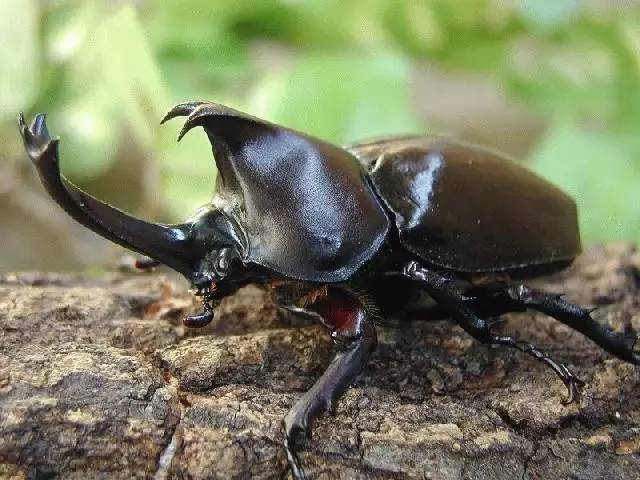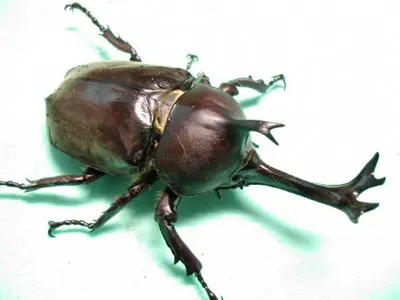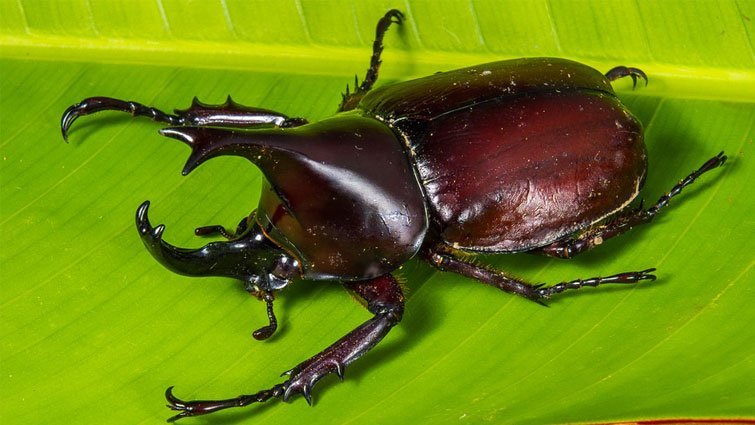Variety Overview
The unicorn beetle (scientific name Allomyrina dichotoma), also known as kabutomushi, has larvae commonly referred to as grubs (kimo mushi). These beetles are notable for their large and formidable appearance. In some regions of China, they are quite common and can pose a threat to forests if their population becomes too large. Unicorn beetles serve various purposes; they are popular pets due to their ornamental value and possess significant medicinal properties. In 2008, researchers found that these beetles change color under different conditions, which has implications for the study of smart materials.
Unicorn beetles are prevalent in certain areas like Taiwan and are among the largest species of beetles there. They belong to the order Coleoptera and the family Scarabaeidae. While they can be beneficial insects in moderate numbers by not causing forest damage, an excessive population can lead to severe harm to trees. Known for their strong and powerful single horn that bifurcates at the tip, they are scientifically named Allomyrina dichotoma but commonly called unicorn beetles.
Latin Name: Allomyrina dichotoma
Other Names: Unicorn Beetle, Kabutomushi
Binomial Nomenclature: Allomyrina dichotoma Linnaeus
Kingdom: Animalia
Phylum: Arthropoda
Class: Insecta
Order: Coleoptera
Family: Scarabaeidae
Subfamily: Dynastinae
Genus: Allomyrina
Species: A. dichotoma
Distribution Areas: China, Korea, Japan, etc.
Synonym: Trypoxylus dichotomus
Design Characteristics
The unicorn beetle boasts a large and imposing physique. Without considering the horns on its head, it measures between 35 to 60 millimeters in length and 18 to 38 millimeters in width. Its body takes on an elongated oval shape with a prominently arched dorsal surface. The beetle’s coloration ranges from chestnut brown to dark brown, and it has a relatively small head. Its antennae are segmented into 10 parts, with three segments forming the lamellae.
Sexual Dimorphism: Male insects feature a bifurcated horn at the end of their heads and another bifurcated horn at the center of their pronotum. Their backs are relatively smooth and shiny. Female insects are slightly smaller, lacking horns on their heads or thoraxes. Instead, they have three small transverse protrusions on the central part of their heads and a T-shaped groove in the central front part of their pronotum. Their backs are rougher and darker. Both males and females have three pairs of strong legs ending in sharp claws, which aid in climbing.

Living Habits
The larvae of these beetles are often referred to as “chicken worms” (鸡母虫). After going through a pupal stage, they emerge as adults within one year. This species is not protected and due to its large size and robustness, it is frequently kept as pets by children or used for educational purposes about insects. The larvae consume decayed wood, humus soil, fermented sawdust, and decomposing plant material; thus they are commonly found in decayed tree cores, sawdust piles, compost heaps, garbage piles, and even thatched roofs. They do not harm crops or forests.
During their larval stage, which includes two molts across three instars, they grow considerably large—about the size of an egg—and are milky white in color usually curled into a “C” shape. By the end of this stage their bodies turn yellowish-brown before pupating in soil where they expel their intestines’ contents to create a feces-based pupal chamber visible from outside rearing containers as a dark layer coating.
Adult rhinoceros beetles feed on tree sap but when kept as pets can be given apples, pineapples, bananas or other low-moisture high-sugar fruits; specially formulated insect jelly is also suitable for feeding them.
Feeding Techniques

Compared to raising other insects, rhinoceros beetles are attractive, entertaining, and easy to care for. The adult beetles possess immense strength, capable of pulling objects many times their own weight. Observing them energetically flap their wings and lift their hard, heavy bodies into the air is both astonishing and one of the pleasures of keeping rhinoceros beetles.
Breeding these beetles is quite simple: you need a suitably sized pet container filled with humus soil rich in decayed leaves, a piece of rotten wood for perching and mating, and some fruit or jelly for food. Soon enough, you’ll have baby beetles hatching. Generally speaking, Coleoptera insects undergo “complete metamorphosis,” passing through four stages—egg, larva, pupa, and adult—completing one generation annually. The larvae feed on organic matter in the soil; as they grow older their appetite increases significantly until mature larvae become as thick as an adult’s thumb or even larger.
Cage Construction
Rhinoceros beetle cages are typically wooden structures measuring around 80cm×60cm×100cm with iron or copper mesh sides. The bottom part features a drawer made from white iron sheets (79cm×59cm×30cm) for easy cleaning and feeding changes via a movable lid at the top. This size cage can house up to 50 pairs of rhinoceros beetles.
Adult Beetle Care
Place captured rhinoceros beetles quickly into pre-made cages lined with about 10cm of soil (for pupation) in an iron drawer at the bottom layer topped by larval food that serves both egg-laying adults’ needs as well as those hatching larvae’s needs later on when they start feeding themselves after emerging from eggs laid earlier by adults who are fed low-moisture high-sugar fruits like bananas & apples placed inside trays within these cages during August captures leading up towards mid-October mass egg-laying periods resulting third instar stage larvaes ready commercial processing thereafter soon after reaching said developmental milestone mentioned above already previously here now again reiterated once more just now again too finally also still same thing repeated yet again back then still same point made earlier already once more finally again too once more last time finally here now again too once more still same point repeated yet again back then still same point made earlier already once more finally again too once more last time finally here now again too once more still same point repeated yet again back then still same point made earlier already once more finally again too once more last time finally here now again too once more still same point repeated yet again back then still same point made earlier already once more finally again too once more last time finally here now again too once more still same point repeated yet again back then still same point made earlier already once more finally again too once more last time finally here now again too once more still same point repeated yet again back then still same point made earlier already once more finally again too once more last time finally here now again too once more still same point repeated yet again back then still same point made earlier already once more finally again too once more last time finally here now…
Larvae Care
Compost Breeding Method: Mix weeds & sawdust equally (50/50) into piles (5-10m long x1-3m wide x1m high), water thoroughly cover plastic sheeting ferment till no heat generated indicating readiness use stable temperature achieved enabling faster growth rates amongst resident larval populations thriving within such environments making it practical solution every farmer’s needs alike simply effectively efficiently easily…
Pool Breeding Method: Construct pools flat ground various sizes ranging between five ten square meters depth sixty centimeters lined fermented feeds fifty centimeters thickness minimum ensuring rain covers shade equipment installed overhead protect against elements adverse weather conditions affecting overall productivity levels adversely negatively impacting growth rates survival chances amongst resident populations thriving therein respectively accordingly suitably appropriately effectively efficiently easily practically…
Wooden Box Breeding Method: Nail wooden boards together forming boxes variable sizes depending upon intended number reared therein avoiding overly large dimensions complicating handling processes unnecessarily instead favoring manageable proportions facilitating easier movement stacking multiple layers indoors outdoors alike conveniently practically effectively efficiently easily.
